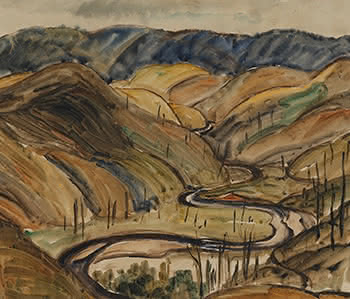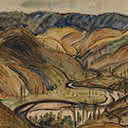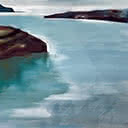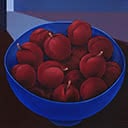Te Whaiti
45 x 51.5 cm
est. $1,000 - 2,000
Helen Brown attended the University of Auckland School of Fine Arts, Elam (1930-37), and was introduced to Cubism by John Weeks. She often went with other pupils of Weeks's on painting holidays in the King Country where they all specialised in the production of sombre hilly landscapes devoid of human subjects.
Like Vida Steinert, Frances Hunt, Jack Crippen, Blanche Hazelwood, and others in the group, Brown's work gradually began to display the particular brand of soft Cubism with which all Weeks students experimented as a means of achieving a more modern conception of form than was practised by painters like Ida Eise, who also taught at Elam.
Brown began painting urban scenes characterised by the simplicity of their form and structure. For a period between 1944 and 1950, such urban scenes formed the basis of Brown's work exhibited with the Rutland Group, an association of Weeks pupils. Members attracted favourable critical attention as the result of their efforts to dissociate themselves from conventional landscape painting shown at Auckland Society of Arts exhibitions.
In 1951 she travelled to London, studying abstract painting and the work of British Constructivist Ben Nicolson. The unpublished letters she wrote to Weeks from Europe are a fascinating record of her thoughts and feelings during this time. After she had assimilated her overseas experience, her art took on a new vigour; her landscapes became bolder in design and more adventurous in colour.
For the following decade Brown sought to reconcile her encounter with abstraction with her experience of the New Zealand landscape. She depicted expansive, empty terrains and harbours characterised by a dramatic reduction of form and space on the surface of the picture plane.
Helen Brown was a member of the Thornhill Group in Auckland during the 1950s. Admired by some critics and occasionally described as 'eccentric,' Brown's art represents a unique and considered response to contemporary painting in the 1950s. Brown is represented in the collections of Te Papa - the Museum of New Zealand and the Sarjeant Gallery in Wanganui.





